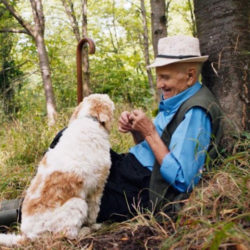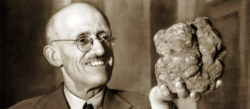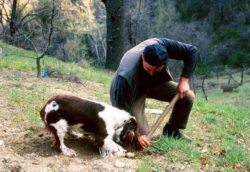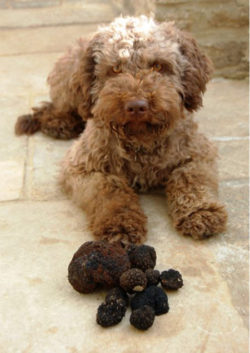Read Time: 4 Minutes Subscribe & Share
Reveling In My Disappointment
 Ever since The Truffle Hunters first appeared on my radar, I have followed all of its travels from its debut at various “serious” film festivals to its purchase by Sony. It was the breathlessly discussed hot documentary at Sundance in January of 2020. The two film-makers were to have unlocked the secret lives of a furtive trade in Piedmont, Italy. The trailer seduced me and probably thousands of others. And so we waited for the Sony overlords to make up their minds how this lush and poetic documentary would make its grand appearance.
Ever since The Truffle Hunters first appeared on my radar, I have followed all of its travels from its debut at various “serious” film festivals to its purchase by Sony. It was the breathlessly discussed hot documentary at Sundance in January of 2020. The two film-makers were to have unlocked the secret lives of a furtive trade in Piedmont, Italy. The trailer seduced me and probably thousands of others. And so we waited for the Sony overlords to make up their minds how this lush and poetic documentary would make its grand appearance.
There was no theater screening that I know of, but Sony did finally release it for streaming earlier this year. To say that it was disappointing is probably due to the hype that rushed through all the food and film websites where I lurk. It reminded me a bit of a film titled First Cow, in which you keep watching the slow unraveling of something that could be a good story, hoping to find something, anything, that makes this film a compelling cinematic narrative. In the truffle documentary, really cool photography and the use of Go-Pro cameras on dogs can only carry the subject matter so far.
Still, I sat there, after my co-watcher gave up to look at the Nats baseball game, because I loved the idea of the film. The two film-makers have a decidedly painterly (and somewhat patronizing) manner as they follow a few senior truffle hunters and their canine partners for the short season of white truffle hunting in Piedmont, Italy. But rather than giving the viewer a cohesive insight into this intriguing pursuit, wholesale trade, and auction, they leave you with a handful of very clever but disparate vignettes. The trailer has all the best ones.
Some Clarity And History
According to the film critic for the New York Times, A.O. Scott – who seemed to be somewhat entranced by the film, it all began with Pliny the Elder, the author of “Naturalis Historia,” his encyclopedia of Roman knowledge in which he described truffles as “marvels of Nature.” But actually, reading from the Urbani website, Sumerians and Babylonians thousands of years before feasted on them as well.
While they were prized by both Greeks and Romans (who of course credited one of Jupiter’s famed thunderbolts hitting an oak tree as the birth of the truffle), truffles devolved into somewhat of a taboo during the Dark Ages and Medieval period in Europe – which shows what happens when misinformation and hearsay become legend. This prized tuber was viewed as a corruption of the earth and reportedly consumed only by witches and devils.
It was not until the 16th century that we have multiple descriptions of truffles at feasts in the houses of Borgia and De Medici. The first real scientific treatise on truffles did not appear until 1821 with a publication by the botanist Carlo Vittadini. And it was not until 1929 that another Italian, prominent restaurateur Giacomo Morra, promoted the local white truffle as the “Truffle of Alba” internationally and created theatrical tasting and selling events. In this photograph, he is holding the largest white Alba truffle ever found. He very cleverly sent out beautiful specimens annually to famous people, like Harry Truman, Winston Churchill and Marilyn Monroe.
Modern Day Differences
 One thing that I did not know was that the French black truffle (which I think has a muskier flavor and aroma) has been successfully propagated with scientific research in France, but the White Alba truffle (to me, more delicate in aroma and flavor) apparently has not. And thus arose the tradition of Piedmont’s truffle hunters. A truffle company in Le Marche uses both modern agricultural technology and old fashioned dog sniffing to harvest truffles and create truffle products without using chemical flavoring substitutes – a practice used in truffle oils, creams and sauces.
One thing that I did not know was that the French black truffle (which I think has a muskier flavor and aroma) has been successfully propagated with scientific research in France, but the White Alba truffle (to me, more delicate in aroma and flavor) apparently has not. And thus arose the tradition of Piedmont’s truffle hunters. A truffle company in Le Marche uses both modern agricultural technology and old fashioned dog sniffing to harvest truffles and create truffle products without using chemical flavoring substitutes – a practice used in truffle oils, creams and sauces. 
The truffle hunters in Italy use dogs and not pigs, the favored breed being the Lagotto Romagnolo. The hunters augment their day jobs (unless like some featured in the film, they have a government pension) during the short truffle season in the fall and are paid in cash. Technically obligated to pay taxes on this income, they do not. It is the resellers who usually fork over the money to the Italian government. Secrecy among the hunters abounds, as they too may be trespassing into private property or into another’s hunting ground. Robberies, dog poisoning, and filling truffle crevices with dirt to increase the weight are part of the game. Global warming has reduced white truffle yields. All of this brings some clarity to this scruffy but romantic source of income and helps explain the devotion to this particular form of fungus. It also, I admit, gives this film a melancholy, disjointed charm. Still, I’m disappointed.

Kitchen Detail shares under the radar recipes, explores the art of cooking, the stories behind food, and the tools that bring it all together, while uncovering the social, political, and environmental truths that shape our culinary world.




Enjoyed the trailer but will take your advice and stop there. Recently read “Being a Dog” where dogs are trained in the Pacific Northwest to sniff out truffles in Washington and Oregon with similar hiding, crimes, tax evasion and allure of the rare fungus.
Hi Andy,
I just ordered “Being A Dog” on your recommendation. I have often wondered how the cultivation of truffles in the Northwest was developing.
Nancy
I was sad to hear that you were disappointed in the film. We stayed at Blackberry Farm where the breed the Lagotto Romagnolo dogs which are adorable! After our stay I heard about the film and was hoping to see it. Won’t wast me time now! Thank you for the review.
Hi Linda,
I thought the dogs were adorable too! There are Instagram accounts about Lagotto Romagnolo accounts. So tempting for my next dog!
Nancy